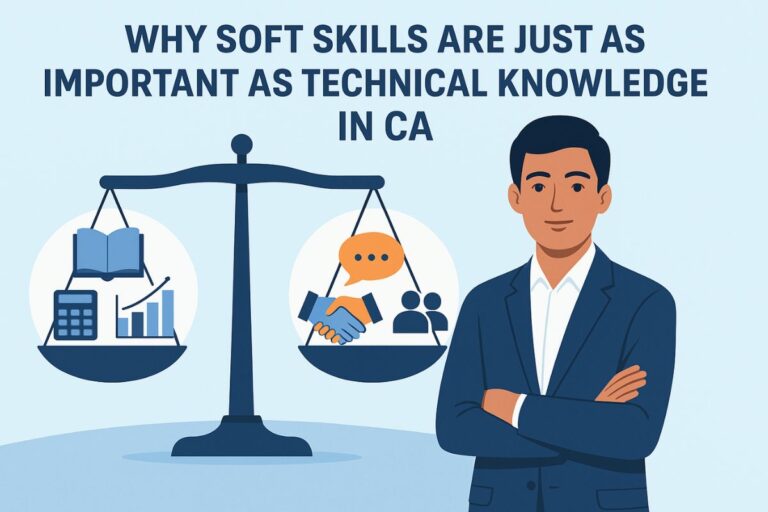The journey of becoming a Chartered Accountant (CA) in India is rigorous and demanding. Alongside clearing the Foundation, Intermediate, and Final exams conducted by the Institute of Chartered Accountants of India (ICAI), practical training forms an essential part of this journey. Two primary modes of such training are CA Articleship and Industrial Training. Both offer valuable experiences but differ significantly in structure, exposure, and career benefits.
This article provides an in-depth comparison between CA Articleship and Industrial Training. It will help students understand which option suits their career aspirations, interests, and circumstances.
Understanding the CA Practical Training Requirement
Becoming a Chartered Accountant is not just about theoretical knowledge and passing exams. Practical experience is indispensable for developing the skills required in the profession. Hence, ICAI mandates students to undergo a period of practical training.
- Articleship is the traditional and compulsory mode of practical training.
- Industrial Training is an optional alternative introduced to give CA students exposure to corporate environments.
Let’s first understand what each of these involves.
What is CA Articleship?
Articleship is a two-year mandatory practical training period during which CA students work under a practising Chartered Accountant or a CA firm. It is designed to provide students with hands-on experience in areas such as:
- Accounting and bookkeeping
- Taxation (Income Tax, GST, TDS)
- Audit and assurance
- Financial reporting
- Company law compliance
- Project finance and consultancy
Structure and Rules
- Students must serve the first year of Articleship under a practising CA or CA firm approved by ICAI.
- The entire duration is two years, spanning various functions of the CA profession.
- Students gain exposure to client handling, documentation, compliance, and professional ethics.
- Articleship is seen as the backbone of the CA curriculum since it solidifies practical skills and professional discipline.
Benefits of Articleship
- Provides comprehensive training in traditional accounting and auditing practices.
- Helps build expertise in tax filing, statutory audits, and financial reporting.
- Offers opportunities to work on diverse client profiles, industries, and assignments.
- Develops critical thinking and problem-solving skills related to compliance.
- Opens avenues for employment in CA firms or setting up one’s own practice post-qualification.
What is Industrial Training?
Industrial Training was introduced by ICAI under Regulation 51 of the Chartered Accountants Regulations, 1988, as an option for students to gain corporate exposure. It is:
- An optional training period lasting 9 to 12 months.
- Available after the student has cleared both groups of the Intermediate examination and completed at least 12 months of Articleship.
- Undertaken in companies registered and notified by ICAI to provide this training.
Nature of Industrial Training
- Focuses on corporate finance functions like budgeting, financial analysis, product pricing, quarterly accounts closing, and strategic management.
- Offers experience of working in departments such as finance, accounts, taxation, internal audit, and business development.
- Exposes students to the functioning of various departments within a corporate structure.
- Emphasises corporate culture, teamwork, office communication, and business ethics.
Benefits of Industrial Training
- Provides insight into the corporate world, which is useful for those aspiring to work in companies.
- Enables practical understanding of business finance and strategy.
- High possibility of job conversion post training in the same organisation.
- Better stipend compared to traditional Articleship.
- Enhances networking opportunities within the corporate sector.
Articleship vs. Industrial Training: A Comparative Analysis
Understanding the key differences between Articleship and Industrial Training is crucial for CA students when making a choice. The following factors highlight the major contrasts:
| Parameter | CA Articleship | Industrial Training |
|---|---|---|
| Mandatory or Optional | Mandatory for all CA students | Optional, but minimum 9 months if chosen |
| Duration | Two years | 9 to 12 months during last year of Articleship |
| Eligibility | Enrolled CA students | Passed both Intermediate groups + 12 months Articleship |
| Scope of Work | Auditing, tax returns, accounting, compliance | Corporate finance, budgeting, pricing, business functions |
| Exposure Type | Client-focused, compliance-heavy | Corporate environment, cross-departmental exposure |
| Availability | Over 42,000 CA firms across India | Limited to select companies mainly in metro & Tier II cities |
| Stipend | ₹3,000 to ₹5,000 per month (varies by city) | Minimum ₹15,000 per month |
| Career Path | CA practice, audit firms, taxation professionals | Corporate finance roles, business management, company jobs |
| Job Conversion Chances | Generally post-qualification | High chance of pre-qualification employment |
| Geographical Reach | Pan-India, including smaller towns and cities | Mainly metro and major Tier II cities |
Availability and Accessibility
One major consideration while choosing between Articleship and Industrial Training is their accessibility.
- Articleship positions are abundant and widely spread. ICAI has registered over 42,000 CA firms ranging from sole proprietorships to large audit firms across India. This widespread network means students from smaller cities and towns can find opportunities easily.
- Industrial Training options, however, are limited and predominantly concentrated in metros and a few Tier II cities. Only companies registered with ICAI for imparting such training can offer it, making availability scarce in smaller cities.
This limited reach makes Articleship a more practical choice for many students based on location.
Stipend Comparison
Financial considerations are significant for CA students, many of whom rely on stipends for their livelihood.
- During Articleship, the stipend amount varies widely. Except for the Big 4 firms and some major CA firms, most provide stipends based on ICAI’s minimum norms, ranging roughly from ₹3,000 to ₹5,000 per month depending on the city.
- Industrial Training offers a substantially higher stipend, with the minimum monthly amount being ₹15,000. This reflects the corporate sector’s valuation of trainees’ work.
The higher stipend in Industrial Training is a big attraction, especially for students who seek financial independence while gaining experience.
Career Path and Opportunities
The training route a student chooses often shapes their career trajectory.
- Articleship is ideal for students planning to become practising Chartered Accountants, work in audit firms, or specialise in taxation and compliance. The hands-on exposure to audit, GST, income tax, and company law prepares students for a professional practice or partnership.
- Industrial Training suits those who envision their future in corporate finance roles, such as financial analyst, budgeting officer, cost accountant, or internal auditor within companies. The exposure to business functions and corporate environment provides a competitive advantage for these roles.
Moreover, industrial trainees have a greater chance of getting absorbed as full-time employees in the same organisation, which can lead to job stability even before final qualification.
Work Experience and Skill Development
The nature of work in Articleship vs. Industrial Training also differs, affecting skill development.
- Articleship Work
- Primarily compliance-oriented tasks such as audit procedures, tax filing, and financial statement preparation.
- Involves client interactions and understanding of legal and regulatory frameworks.
- Develops technical skills in auditing, accounting standards, and taxation.
- Industrial Training Work
- More varied with cross-functional exposure including product pricing, budgeting, cost control, management reporting.
- Focus on corporate governance, strategy, and internal processes.
- Develops skills in corporate communication, teamwork, and business management.
Both forms of training equip students with distinct skills suited for different professional environments.
Balancing Industrial Training and CA Final Preparation
A concern for many students opting for Industrial Training is the time commitment.
- Industrial Training requires spending significant time in office work, which may reduce time available for CA Final exam preparation.
- However, with the revised CA curriculum, students can begin Industrial Training after completing the first year of Articleship. This allows them to plan their schedule and dedicate approximately 6 to 8 months for exam preparation after training.
- This flexibility makes Industrial Training an attractive option for students who want corporate exposure without compromising on their studies.
Challenges of Industrial Training
While Industrial Training has its advantages, students should be mindful of certain challenges:
- Limited availability may mean that many students cannot access this option.
- The work can be intense with long office hours, impacting personal study time.
- Since Industrial Training is optional, some students may face pressure or confusion when deciding between the two options.
- Exposure may be limited to a single department or function, unlike Articleship which offers broader exposure to various accounting and auditing tasks.
How to Decide Between Articleship and Industrial Training?
Choosing between CA Articleship and Industrial Training depends on multiple factors:
1. Career Goals
- Do you want to become a practising Chartered Accountant, start your own firm, or join an audit/tax consultancy?
Articleship is your best choice. - Are you keen on working in the corporate sector in finance, management, or business roles?
Industrial Training offers the right exposure.
2. Location and Accessibility
- If you live in a smaller city or town, Articleship is more accessible.
- If you are based in metro cities and can access corporate companies, Industrial Training is an option.
3. Financial Needs
- If stipend amount is a priority, Industrial Training provides higher financial support.
- However, consider the overall experience and long-term career benefits, not just stipend.
4. Study Preferences
- Articleship generally allows more study flexibility.
- Industrial Training demands office hours that may limit study time, but the new curriculum provides a balance.
Conclusion
Both CA Articleship and Industrial Training have their unique advantages and challenges. Articleship remains the foundation of practical CA education, offering deep knowledge in auditing, taxation, and accounting, and is essential for those pursuing traditional CA practice.
On the other hand, Industrial Training is a valuable alternative for students interested in the corporate world, providing exposure to business functions, corporate culture, and better financial rewards.
Ultimately, the decision should be guided by your personal career ambitions, financial considerations, location, and study preferences. Careful evaluation and planning will ensure that whichever path you choose, you gain the most from your practical training phase on your journey to becoming a successful Chartered Accountant.
Calling all CA dreamers!
🔴 Are you tired of searching for the perfect articelship or job?
Well, fear no more! With 10K+ students and professionals already on board, you don't want to be left behind. Be a part of the biggest community around! Join the most reliable and fastest-growing community out there! ❤️
And guess what? It’s FREE 🤑
✅ Join our WhatsApp Group (Click Here) and Telegram Channel (Click Here) today for instant updates.




